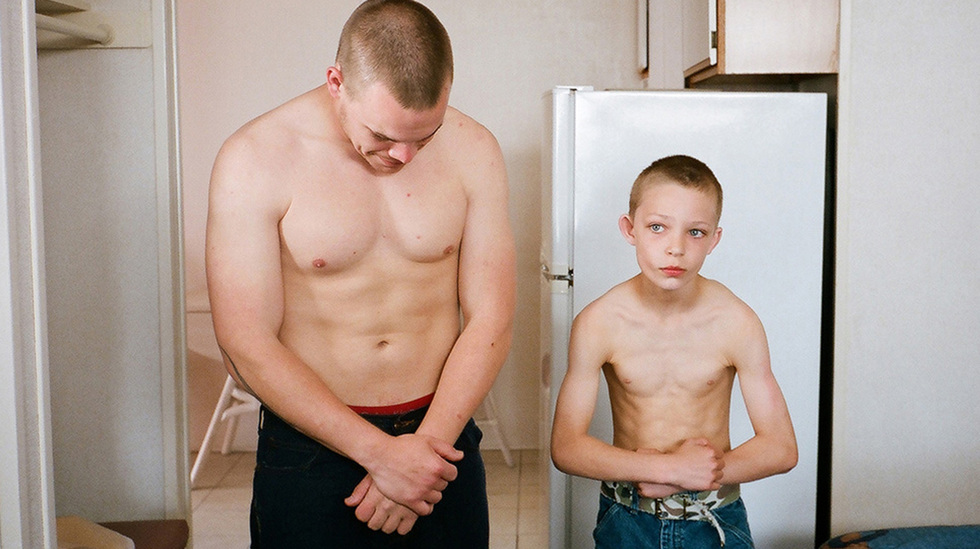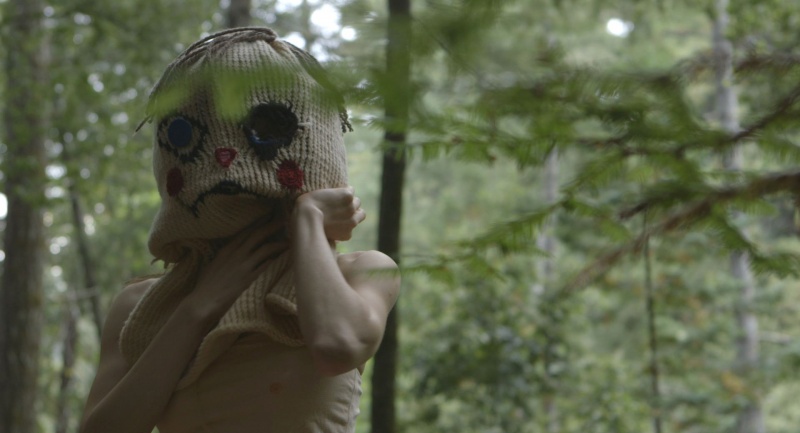
“Roaming far from home:” Young Bodies Heal Quickly – Sundance Cinema 5 (6:00-7:45p)
The cousin twice removed from Terrence Malick’s Badlands (1973) through Harmony Korine’s signature spontaneity and David Gordon Green’s spiritual Southern Gothic, George Washington (WFF 2001), Andrew T. Betzer’s feature-length debut, a road movie of unchecked physicality and visual vigor, isn’t quite contained in an engaging narrative or character study. Young Bodies Heal Quickly‘s minimalistic, nomadic vignette-style approach actually seems emotionally resistant as its two unnamed brothers, the muscular Older (professional wrestler Gabriel Croft) at least ten years the senior of the lithe Younger (Hale Lytle), flee the scene of manslaughter while on a roughhousing rampage through the rural fields of Maryland.
With a little motherly direction, they first plow into their Sister (Kate Lyn Sheil)’s farmhouse where she lives with her carpenter husband and son Mosiah (Mosiah Maddox), but the older brother’s persistent recklessness forces sis to drive him away. The film’s rhythm proves this fugitive visitation as inevitable; however, for the sake of psychological background, there is a noticeable disinterest in building relationships at this point in the boys’ story. This quickly becomes problematic, as it lures the viewer into perceiving each eccentric encounter as a kind of sketch comedy punctuated by weathered sounds of Hank Williams and close-ups of food preparation as people nourish to regain their waning strength and acuity.
After the Younger flags down a French hotel maid Sheila (Julie Sokolowski) to help rescue the unconscious the Older from a shoreline, a love triangle plays out in miniature between the maid, the older brother, and a deranged cleaver-brandishing chef (Alexandre Marouani). Fleeing the scene again, the two continue on dirt trails before ending up at the bayside home of a reclusive Vietnam War veteran (Daniel P. Jones), who possesses a seriously troubling Nazi fixation. Their rapport is playfully strange but never achieves such emotional resonance as the film continues to barrel through to a self-indulgent, questionable final act featuring an insensitive war reenactment. Although it would seem that the exploration of the physical space of the mock forest-as-jungle battlefield would well-complement its opening tableau, there’s a decisive, almost ironic lack of danger and purpose to the tortuous sequence. Sometimes, abbreviated scenes in a confined area, like an evening crab feast, most effectively and entertainingly bottle the characters’ distinctive energies, traits, and worldviews.

“Anti-phallic symbol:” Felt – Cinematheque (9:15-10:35p)
In what is likely to lunge to the forefront of the most disturbing and divisive (but vital) entries in this year’s festival, Jason Banker’s psychological horror film begins with a confrontational voice-over of a damaged young woman, Amy (Amy Everson), unable to deal with an unseen trauma, but the words quite clearly prepare its observation on gender identity and the taboo topic of rape culture. Felt is less of an exposé like Justin Simien’s Dear White People (2014) than it is a thematic stitching of a lone character study with an element of ambiguous autobiography that peers into the void and asks, “Is (performance) art therapeutic, or is it conjuring a cosmic stigmata?” In the film’s examination of a misunderstood character with a preference for wounded self-expression in crocheted crafts, the film shares a curious link to Lucky McKee’s May (2002), especially in the way they both perpetually escalate the sense of dread while suppressing horror tropes.
Felt, however, is less about a character’s youth as a bearing on her adult development than it is a recent incident, which lends the film a type of harrowing urgency that May lacks. Further, there’s an inherent fascination in examining Banker’s from any school of literary theory, because it’s a purely female forum as directed by a man. Amy exerts her entire being to reclaim her identity, sexual and otherwise, through the dismantling and ridicule of the perpetrating opposite sex. Besides the phallic imagery that dominates her arts and crafts, Amy inhabits a male persona, inflates it, and destroys it; her costumes take aim at the reality of men either directly or indirectly flaunting their masculinity in her ostentatious representation of the anatomy through a series of lumbering gestures of an oppressive Neanderthal. These scripted, silent, stylized pieces of performance art in the film, often scored with a hauntingly melancholic piano-synth theme, are undeniably unnerving, but they are jarringly juxtaposed against sporadically loose improvisatory dialogue when Amy is in the company of her considerably more sociable friends. This is perhaps a flawed product of the method itself, yet one might fasten the two divergent styles that shape the unstable tone as an expression of Amy’s volatile psyche.
Just when Amy seems to turn over a new leaf after meeting a receptive and supportive man, Kenny (Kentucker Audley), at a bar, he, too, harbors a damaging secret. The film’s consciousness becomes burdened by a predictable revelation that will invariably lead to greater tragedy and the grand revenge machination. Yet there’s something unquantifiable about Felt‘s power and magnetism for much of its duration, examining the unique means of human coping with scarring circumstance. In this externalized confrontation of the self, in which Amy intends to reverse victimization, to objectify the objectifiers, Felt is as much an artistic declaration of empowerment than it is one of gender-specific transformation: the reality of making and remaking oneself in a certain image. While this film and the favorable Phoenix from Saturday night at the festival are vastly different films, they converge with their most fascinatingly layered presentations of both the fragility and durability of human identity. Like Nina Hoss in the aforementioned film, the psychological dimension of Felt is highly dependent on the resiliency of physical performance. Here, Amy Everson’s mannerisms alternately convey an aloofness and intense awareness; from her detachment and likeness to one of the knitted dolls that line the walls of her safe haven, there emerges an indescribably affecting, unyielding on-screen figure.
